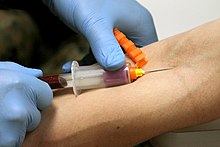真空採血管
真空採血管(Vacutainer)是一種真空無菌玻璃或塑料管封閉的血液收集管,管內的真空促進預定的液體量輸入。這種真空管通常用來靜脈採血,也有的用來收集尿液樣本。真空管管壁有時會有一層添加劑來幫助穩定和保存樣本。
真空採血管由碧迪醫療的Joseph Kleiner於1947年發明[1] ,Vacutainer是碧迪醫療銷售真空採血管的商標名。
Principles
[編輯]
Vacutainer needle are double ended, with one side being encased in a thin rubber coating for safety. When the needle is screwed into the translucent plastic needle holder, the rubber needle is inside the holder, and the exposed needle will be inserted into the vein. When a Vacutainer tube is inserted into the holder, its rubber cap is punctured by the inner needle and the vacuum in the tube pulls blood through the needle and into the tube. The filled tube is then removed and another can be inserted and filled the same way. The amount of air evacuated from the tube predetermines how much blood will fill the tube before blood stops flowing.
Each tube is topped with a color-coded plastic or rubber cap. Tubes often include additives that mix with the blood when collected, and the color of each tube's plastic cap indicates which additives it contains.
Blood collection tubes expire because over time the vacuum is lost and blood will not be drawn into the tube when the needle punctures the cap.
Types of tubes
[編輯]
Vacutainer tubes may contain additional substances that preserve blood for processing in a medical laboratory. Using the wrong tube may make the blood sample unusable for the intended purpose. These additives are typically thin film coatings applied using an ultrasonic nozzle.
The additives may include anticoagulants (EDTA, sodium citrate, heparin) or a gel with density between those of blood cells and blood plasma. Additionally, some tubes contain additives that preserve certain components of or substances within the blood, such as glucose. When a tube is centrifuged, the materials within are separated by density, with the blood cells sinking to the bottom and the plasma or serum accumulating at the top. Tubes containing gel can be easily handled and transported after centrifugation without the blood cells and serum mixing.

The meanings of the various colors are standardized across manufacturers.[2][3][4]
The term order of draw refers to the sequence in which tubes should be filled. The needle which pierces the tubes can carry additives from one tube into the next, so the sequence is standardized so that any cross-contamination of additives will not affect laboratory results.[4]
Containers containing coagulants
[編輯]- Gold or "tiger" red/black top: clot activator and gel for serum separation
- Red top (plastic, not glass): clot activator but no serum separation gel
- Orange or grey/yellow "tiger" top: thrombin, a rapid clot activator, for stat serum testing
Containers containing anticoagulants
[編輯]- Green: sodium heparin or lithium heparin used for plasma determinations in clinical chemistry (e.g. urea and electrolyte determination). Sodium heparin collection tubes are the classically preferred tube for peripheral blood or bone marrow for cytogenetic studies. Lithium heparin is considered suboptimal for cytogenetics.[來源請求]
- Light green or green/gray "tiger": for plasma determinations.
- Purple or lavender: K2 EDTA. This is a strong anticoagulant and these tubes are usually used for complete blood counts (CBC). Lavender top tubes are generally used when whole blood is needed for analysis. Can also be used for some blood bank procedures such as blood type and screen. EDTA tubes are preferred by most molecular genetics laboratories for molecular genetic studies (DNA or RNA).[來源請求]
- Grey: sodium fluoride and oxalate. Fluoride prevents enzymes in the blood from working, by preventing glycolysis so a substrate such as glucose will not be gradually used up during storage. Oxalate is an anticoagulant.
- Light blue: sodium citrate. Citrate is a reversible anticoagulant, and these tubes are used for coagulation assays.
- Dark blue: EDTA. These tubes are used for trace metal analysis.
- Black: used for Erythrocyte Sedimentation Rate (ESR).
Other
[編輯]- Red (glass): contains no additives.
- Light yellow: contains sodium polyanethol sulfonate (SPS). Used for blood culture specimens or acid-citrate-dextrose (ACD), used for blood bank studies, HLA phenotyping, and paternity testing.
- Tan (glass or plastic): contains either sodium heparin (glass) or K2EDTA (plastic). Used for lead determinations. These tubes are certified to contain no lead.
History
[編輯]
History
[編輯]Vacutainer technology was developed in 1947 by Joseph Kleiner,[1] and is currently marketed by Becton Dickinson (B-D).[5]
The plastic tube version, known as Vacutainer PLUS, was developed at B-D in the early 1990s by E. Vogler, D. Montgomery and G. Harper amongst others of the Surface Science Group as US patents 5344611, 5326535, 5320812, 5257633 and 5246666.[6]
Vacutainers are widely used in phlebotomy in developed countries due to safety and ease of use. Vacutainers have the advantage of being prepared with additives, allowing easy multi-tube draws, and having a lower chance of hemolysis.[7] In developing countries, it is still common to draw blood using a syringe or syringes.
參考
[編輯]- ^ 1.0 1.1 Rosenfeld L. A golden age of clinical chemistry: 1948–1960. Clin Chem. 2000, 46 (10): 1705–14 [2015-10-04]. PMID 11017957. (原始內容存檔於2011-06-07).
- ^ Specimen Collection Tubes & Containers. [2006-02-01]. (原始內容存檔於2006-02-12).
- ^ Quick Collection List. [2006-02-01]. (原始內容存檔於2005-12-16).
- ^ 4.0 4.1 Blood collection: routine venipuncture and specimen handling. [2006-02-01]. (原始內容存檔於2006-01-29).
- ^ BD Vacutainer Venous Blood Collection – Tube Guide (PDF). [2007-05-30]. (原始內容 (PDF)存檔於2014-11-13).
- ^ US Patent Office Patent number search. [2019-05-02]. (原始內容存檔於2019-04-28).
- ^ Ames, A.C.; Bamford, E. An Appraisal of the "Vacutainer" System for Blood Collection. Annals of Clinical Biochemistry: An International Journal of Biochemistry and Laboratory Medicine. 1975, 12 (1–6): 151–55. PMID 15637911. doi:10.1177/000456327501200136.
